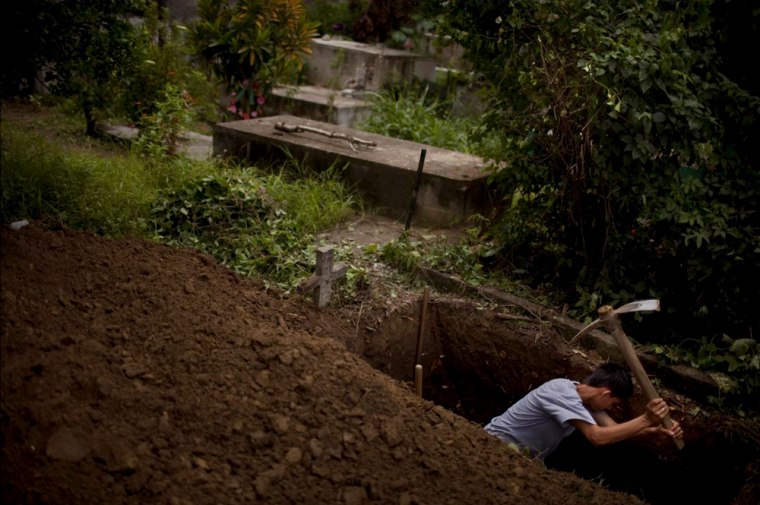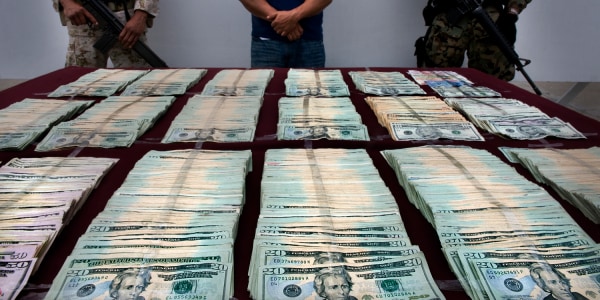Josue Oviedo looked into his sister’s fading eyes as she fought to speak her last words.
“She was trying to tell me something,” he said, a day after the funeral for Daisy Oviedo Mejía, 22, who died in a storm of bullets while watching her brother play soccer a few weeks ago. “But she couldn’t. I gave her mouth-to-mouth but there was too much blood.”
Ms. Oviedo, a primary school teacher who liked to dance and sing with her students, was one of four people killed that day when gunmen opened fire at a park, the second such massacre here since November. She was innocent, the authorities said, another casualty in the violence and social ills rocking Central America as criminal groups turn the region into a main artery for funneling cocaine north to the United States.
Traffickers have used Central America as a stopover point since at least the 1970s. But the aggressive crackdowns on criminal organizations in Mexico and Colombia, coupled with strides in limiting smuggling across the Caribbean, have increasingly brought the powerful syndicates here, pushing the drug scourge deeper into small Central American countries incapable of combating it.
Most of the known cocaine shipments moving north, 84 percent of them, crossed through Central America last year, according to radar tracking data from American authorities — a sharp increase from 44 percent in 2008 and only 23 percent in 2006, the year President Felipe Calderón of Mexico took office and began his assault against the drug gangs in his country.
Slideshow 32 photos
Narco culture permeates Mexico, leaks across border
Responding to the pressure — and opportunity — the cartels have spread out quickly. Five of Central America’s seven countries are now on the United States’ list of 20 “major illicit drug transit or major illicit drug producing countries.” Three of those, Costa Rica, Nicaragua and Honduras, were added just last year.
At the same time, management has changed. Mexican cartels have taken over from Colombians in recent years, recruiting local gangs to help bolster shipments, increasing consumption by paying with drugs and expanding extortion and kidnapping networks to round out their enterprise.
“This is David versus Goliath,” said Marlon Pascua, Honduras’s defense secretary. “And we are David fighting the giant.”
Exploiting vulnerabilities
The issue took center stage when President Obama, during a visit to El Salvador on Tuesday and Wednesday, announced a plan to fight organized crime in the region by strengthening civilian institutions and providing training for local authorities, weapons and equipment.
But such promises have been made before, and many Central American leaders are frustrated by the wait. Of the $1.6 billion in law enforcement support promised under the antidrug Merida initiative announced in 2007, $258 million was assigned to Central America. Yet only $20 million of it had actually been spent by April of last year, according to the Government Accountability Office.
Meanwhile, the problem continues to metastasize. American officials say the 2009 coup in Honduras kicked open the door to cartels, and this month the authorities there made a troubling find: a major cocaine processing lab, suggesting that the region was becoming not just a way station for drugs, but also a manufacturer.
Even once peaceful corners like Costa Rica are struggling with addiction, gangs and drug-money corruption. Without immediate help, said José María Tijerino Pacheco, Costa Rica’s minister of public security, “the region is going to degenerate into another Mexico.”
The American military’s map of suspected drug plane and boat traffic heading from South America to Central America last year shows scores of lines running north. On the Atlantic side is a pistol-shaped arc of flights: the handle is the Venezuela-Colombia border and the barrel is pointed at Honduras’s Caribbean coast. On the Pacific side, the tracks show mostly boats — with dozens of lines heading from Colombia to an area of Costa Rica famous for fishing.
Both routes are increasingly popular: suspected drug flights to Honduras spiked to 82 last year, up from only 6 in 2006; in Costa Rica, there were 100 “maritime events,” up from just 12 five years ago.
The patterns reveal how drug traffickers exploit the region’s geographic, political and economic vulnerabilities. In Honduras, the coast northeast of San Pedro Sula offers a remote, largely uninhabited rainforest that is perfect for the single-engine planes traffickers use, then hide or burn to destroy the evidence.
One former smuggler said he had little trouble moving cocaine loads for years. He said he collected pound after pound from planes and then drove it by boat or car to the Guatemala border, without once being caught.
“We always got it through,” he said, withholding his full name for fear of reprisals.
Honduran officials hardly dispute such claims, saying the radar system they would need to closely track the planes would cost $30 million, and even then, they would need helicopters and other equipment to quickly intervene. The coup only made matters worse, because the Honduran military was diverted to containing street protests and American officials suspended anti-narcotics aid in response to the political crisis.
'Not much we can do'
In Costa Rica, the Pacific Coast has proven just as porous. Speedboats with contraband ply the shipping lanes, according to fishermen in Puntarenas, the country’s main Pacific port. They say their radios have been crackling for years with cartel requests for food or offers of a few thousand dollars to carry drugs ashore.
That is, if the traffickers do not own the boats already. Chamber of Commerce officials in Puntarenas said that people suspected of being cartel leaders have bought at least a half-dozen fishing businesses over the past few years, coercing sales either with the barrel of a gun or by offering more than the going rate at a time when fishing yields are declining.
Mauricio Boraschi, who occupies a newly created position as Costa Rica’s drug czar, said the Mexican cartels were gobbling up any legitimate business to hide their product. “They buy everything — the farms, the means of production, the transport,” Mr. Boraschi said. “It’s all to move cocaine.”
At the small Coast Guard base in Puntarenas, most of the guardsmen admit they are outmatched. “It’s extremely frustrating,” said Pastor Reyes González, the commander. “There is not much we can do.”
He pointed to his boats. The smaller ones, he said, were too slow to intercept the cartels’ speedy skiffs. Of the unit’s three larger boats, only one had a functioning engine. And that was a hand-me-down from the Americans, commissioned in 1960.
All around the country’s 801-mile coastline, the story is the same. Of Costa Rica’s 26 boats involved in security, only 14 function, said Mr. Tijerino, the minister of public security. Even the largest Coast Guard stations, he said, can cover only 5 percent of their territory — and even less at night because they lack proper equipment.
Costa Ricans used to joke about such limitations. The country abolished its military in 1948, and with a motto of “pura vida,” or pure life, it has spent decades cultivating an image of easygoing democratic stability.
But what had been a point of pride has now become a vulnerability — and a catalyst for requests for help.
In Costa Rica and in Honduras, as with other countries in the region, the largest seizures have come only with American assistance. Just a few weeks ago, after American radar picked up a plane near the Honduran coast, Drug Enforcement Administration helicopters with night vision gear helped pinpoint where the plane landed. Oscar Álvarez, the security minister, said its cocaine was seized, but only because the police and American agents happened to be training nearby. Even these victories can be fleeting. Last year, a single-engine plane that had been seized and stored at a military base in San Pedro Sula disappeared. Five armed men somehow slipped past guards, broke into the hangar and flew the plane away.
Consequences pile up
Central America is not just awash in smugglers. The region has become a major cocaine consumer, starting a few years ago when the cartels began paying people in kind. Local dealers quickly turned those payments into crack that sells for $1 a hit.
The consequences continue to multiply. Urban areas and coastal towns are experiencing more drug-related crime, while treatment centers are as overwhelmed and ill prepared as the police.
In San Pedro Sula, Honduras, all of the slots at the drug treatment center were full during a recent visit. The closest alternative was a six-hour drive away.
In Puntarenas, Costa Rica, the drug center offered a portrait of what happens when cartels infiltrate a town of 10,000 people, in a country smaller than West Virginia. Housed in an antique train depot, the center was full, as usual, with 32 struggling men.
“Demand for help has doubled since last year,” said Hanzel Mora Badilla, 26, the center’s manager. “Every year, it doubles.”
He pulled out a heavy ledger identifying everyone who has passed through. Only about one in 100 get clean for good, Mr. Badilla said, so the book was mostly a casualty list of the come and gone: Fernando, 24, a carpenter addicted to crack; Miguel, 52, a fisherman addicted to crack; Marvin, 22, Juan, 37, José, 30 — page after page, name after name, each a tragedy in shaky script.
“They’re zombies,” said Mr. Boraschi, Costa Rica’s drug czar. Some, he added, are also dangerous.
A month ago, the Costa Rican police found a couple that had been killed in a neighborhood of Puntarenas called Progress. They were known as the area’s main dealers, and the police said they were killed because they owed a debt to Mexican bosses.
But for those who knew them before they joined the cartel economy, they exemplified a wider, regional spiral.
Jesús E. Chávez, one of the Coast Guard officers in Puntarenas, said the dead dealer had been a school classmate. “He was a good kid,” he said. But, Mr. Chávez noted, drugs and money in Central America have become hard to resist.
“The narcos are hiring our good workers, people I know,” Mr. Chávez said, describing a raid in which he found himself facing a neighbor who lived three houses away.
That is exactly what frightens the people and leaders of small countries like Costa Rica and Honduras. While Mexico continues to struggle with heinous violence, its murder rate is still relatively low, at 12 per 100,000 people. In Honduras, the already high murder rate has climbed rapidly and is much higher than Mexico’s — at 66.8 per 100,000 people, it is the worst in Central America.
Ms. Oviedo’s father, Gonzalo Oviedo, knew the statistics. He preached nonviolence in San Pedro Sula and in nearby La Lima, where his daughter lived and worked at the religious school the family runs.
Never did he imagine, he said, that his words and faith would be so tested.
“It is not easy to have hope,” he said. “What we have is desperation, anguish and fear.”
Randal C. Archibold reported from San Pedro Sula, and Damien Cave from Puntarenas, Costa Rica.
This story, "", originally appeared in The New York Times.

